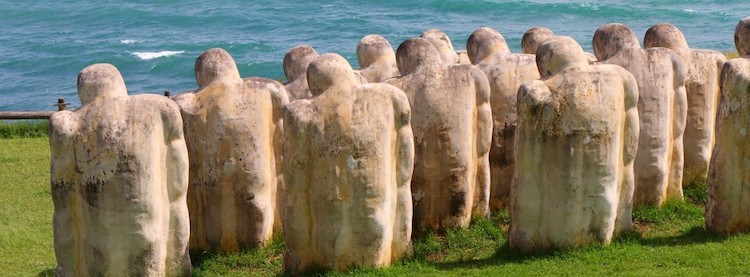Viewpoint by Ali Moussa
The writer is Coordinator of UNESCO’s Slave Route Project. This article first appeared on UNESCO Website on 22 August 2019, a day before the International Day of Remembrance of the Slave Trade and its Abolion initiated by UNESCO.
PARIS (IDN-INPS) – Among the major crimes that have marked human history, the slave trade and slavery are distinguished by their magnitude, their duration and the violence that accompanied them. It is difficult to understand how a tragedy of this scale could have been ignored for so long.
Historians estimate that thirty million Africans were deported from different parts of Africa and enslaved in other regions of the world. If we add the number of those who died during capture, the arduous journey towards various ports, the holding camps, and the middle passage, there were, in fact, near a hundred of millions of lives that were taken from Africa.
This massive outward forced migration had resulted in a population decline for at least four centuries. Demographers have calculated that the total number of Africans at the end of the nineteenth century should have reached two hundred million, rather than an estimated hundred million. Imagine the potential that was lost across an entire continent and the vulnerabilities created and further exploited.
Denials of Dignity and Resistance
The slave trade and slavery had another peculiar consequence. They left in their wake the tenacious poison of racism and discrimination that plagues people of African descent today. Throughout this history, black people across the world have had to confront three kinds of denials that have served to justify and legitimize the slave trade, slavery, colonization, segregation and apartheid since the 15th century. They are:
– The denial of their humanity and dignity through numerous attempts to reduce them to the status of beasts of burden, in view of dehumanizing them.
– The denial of their history and culture through pseudo-scientific discourses aiming at minimizing their role in human history.
– The denial of their rights and citizenship through all types of policies, laws, and strategies of discrimination.
It is to fight this legacy of racial prejudices, still disseminated through the media, cinema, television, textbooks that the United Nations has proclaimed in 2014 the International Decade for People of African Descent (2015-2024) to promote the fulfilment of all human rights and fundamental freedoms of people of African descent and a greater knowledge of their contribution to humankind.
Despite the extreme violence of this system of oppression, codified by the monstrous Black Codes, the enslaved Africans never ceased to resist. Using the full potential of their culture, they not only survived the conditions of dehumanization but also contributed to transforming slave societies through their social ingenuity and artistic creavity, which produced the extraordinary cultural diversity.
Lessons from History
 Permanent Memorial to honour the victims of slavery and the transatlantic slave trade at the United Nations. The Ark of Return was unveiled on 25 March 2015 in New York.
Permanent Memorial to honour the victims of slavery and the transatlantic slave trade at the United Nations. The Ark of Return was unveiled on 25 March 2015 in New York.
Cognizant that ignoring such major historical events constitutes in itself an obstacle to peace, mutual understanding, and reconciliation, UNESCO launched in 1994 the Slave Route Project to contribute to this reflection. The ethical, political and cultural stakes of this project were clearly articulated from the very beginning. The barbarity that societies are capable of unleashing, especially those societies claiming the privilege of civilization are the stakes.
Moreover, comprehension of this chapter in world history makes it possible to better grasp the genealogy that binds the slave trade to other historic crimes such as the extermination of indigenous peoples in the Americas, the Holocaust, Apartheid and more recent genocides.
The slave trade and slavery are therefore founders of our modern world. Through the capital accumulated during trade which contributed to the enrichment of Europe and America, the common heritage which is the main source of today’s artistic creations, and through the combat against slavery which has profoundly redefined the very notion of liberty, dignity and universality, this history has participated in the emergence of modernity.
This tragedy concerns the whole of humanity and calls out to all of us, because of the universal silence that has surrounded it, the troubling light it sheds on the discourse used to justify it, and the psychological scars it has left in our souls.
It also challenges us to confront some of today’s burning issues in post-slavery societies: cultural pluralism, mutual respect, reparations, and national reconciliation. It helps to better fight against new forms of servitude that continue to affect millions of people, in particular women and children, in different parts of our world. [IDN-InDepthNews – 29 August 2019]
Photo: The night of 22 to 23 August 1791, in Santo Domingo (today Haiti and the Dominican Republic) saw the beginning of the uprising that would play a crucial role in the abolition of the transatlantic slave trade. Credit: UNESCO
Photo in text: Permanent Memorial to honour the victims of slavery and the transatlantic slave trade at the United Nations. The Ark of Return was unveiled on 25 March 2015 in New York.
IDN is flagship agency of the International Press Syndicate.
facebook.com/IDN.GoingDeeper – twitter.com/InDepthNews

